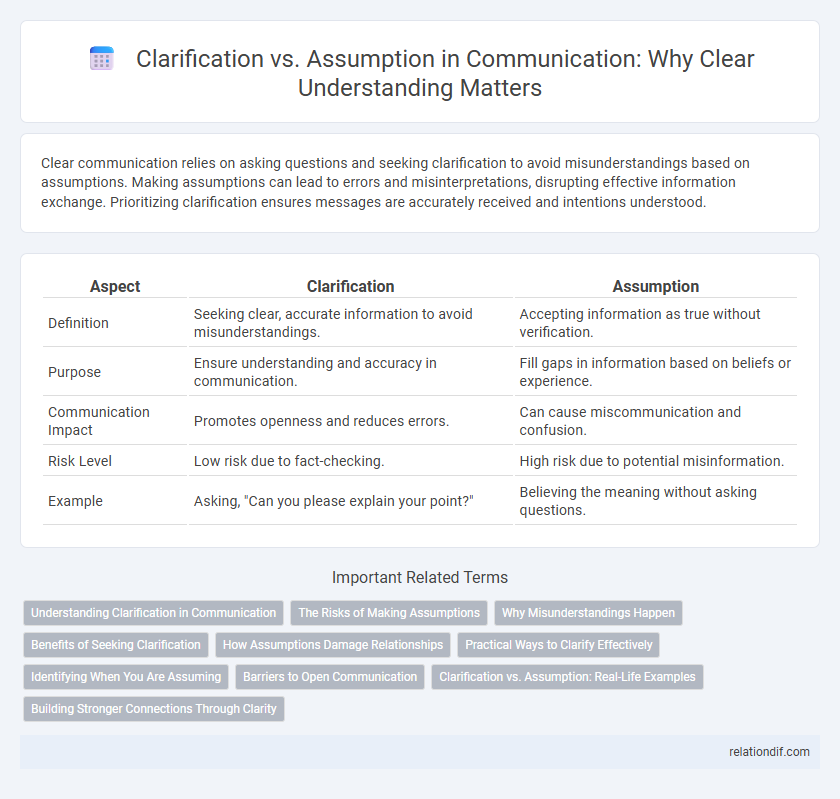Clear communication relies on asking questions and seeking clarification to avoid misunderstandings based on assumptions. Making assumptions can lead to errors and misinterpretations, disrupting effective information exchange. Prioritizing clarification ensures messages are accurately received and intentions understood.
Table of Comparison
| Aspect | Clarification | Assumption |
|---|---|---|
| Definition | Seeking clear, accurate information to avoid misunderstandings. | Accepting information as true without verification. |
| Purpose | Ensure understanding and accuracy in communication. | Fill gaps in information based on beliefs or experience. |
| Communication Impact | Promotes openness and reduces errors. | Can cause miscommunication and confusion. |
| Risk Level | Low risk due to fact-checking. | High risk due to potential misinformation. |
| Example | Asking, "Can you please explain your point?" | Believing the meaning without asking questions. |
Understanding Clarification in Communication
Clarification in communication ensures the accurate transmission of information by seeking explicit explanations and confirming understanding, reducing the risk of misinterpretation. It involves asking targeted questions and rephrasing statements to verify meaning, which strengthens mutual comprehension between parties. Unlike assumptions, which rely on unverified beliefs, clarification promotes clear, effective dialogue essential for successful interpersonal and professional interactions.
The Risks of Making Assumptions
Making assumptions in communication often leads to misunderstandings, misinterpretations, and errors that can damage relationships and hinder collaboration. Without clarification, assumptions create gaps in knowledge and propagate false information, resulting in decreased efficiency and increased conflict. Prioritizing clear, direct communication minimizes risks by ensuring all parties share the same understanding and expectations.
Why Misunderstandings Happen
Misunderstandings occur primarily because assumptions fill gaps where clarity is missing, leading to distorted interpretations of messages. Without explicit communication, individuals project their own experiences and biases onto the information received, causing misalignment in meaning. Effective clarification prevents these errors by ensuring both parties share an accurate and mutual understanding.
Benefits of Seeking Clarification
Seeking clarification prevents misunderstandings by ensuring the intended message is accurately received, which enhances overall communication effectiveness. It fosters a collaborative environment where questions are encouraged, leading to more precise decision-making and reduced errors. Clarification also builds trust among team members by demonstrating a commitment to transparency and active listening.
How Assumptions Damage Relationships
Assumptions create misunderstandings by filling gaps with inaccurate interpretations, leading to mistrust and conflict in relationships. Clarification fosters open dialogue, ensuring that intentions and expectations are accurately understood, which strengthens connection and cooperation. Miscommunication caused by assumptions often results in emotional distance and weakened bonds between individuals.
Practical Ways to Clarify Effectively
Effective communication relies on clear clarification to prevent misunderstandings caused by assumption. Asking concise, specific questions and paraphrasing the speaker's message ensures accurate comprehension and minimizes errors. Utilizing active listening techniques and confirming details promptly enhances clarity and builds trust in professional and personal interactions.
Identifying When You Are Assuming
Identifying when you are assuming involves recognizing gaps in information where you fill in details without verification. Assumptions can lead to misunderstandings and communication breakdowns if left unaddressed. Clarification techniques such as asking direct questions or paraphrasing help ensure accurate understanding and prevent errors.
Barriers to Open Communication
Barriers to open communication often arise from assumptions that distort the intended message, leading to misunderstandings and decreased collaboration. Clarification involves actively seeking to understand the speaker's intent through questions and feedback, which reduces misinterpretations and builds trust. Failure to clarify results in reliance on assumptions that create confusion, conflict, and communication breakdowns within teams or organizations.
Clarification vs. Assumption: Real-Life Examples
Clarification involves actively seeking specific information to ensure accurate understanding, such as asking precise questions during a business meeting to confirm project deadlines. Assumption occurs when individuals infer meaning without verifying facts, like interpreting a colleague's brief email as dissatisfaction without asking for more details. Real-life examples highlight that clarification reduces misunderstandings and improves collaboration, while assumptions often lead to conflicts and mistakes in communication.
Building Stronger Connections Through Clarity
Clarification fosters stronger connections by ensuring messages are accurately understood, reducing misunderstandings that arise from assumptions. Asking precise questions and confirming information promotes trust and transparency in communication. Prioritizing clarity strengthens relationships by creating an environment where open, honest dialogue thrives.
clarification vs assumption Infographic

 relationdif.com
relationdif.com